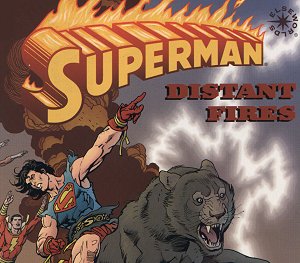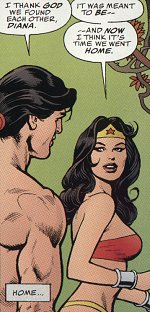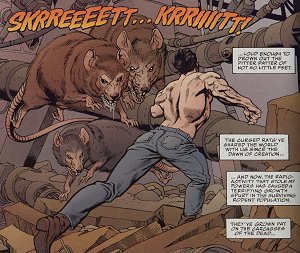Superman: Distant Fires

 As I write this review, there’s a discussion taking place in rec.arts.comics.dc.universe about the clichés of DC’s “Elseworlds” stories. For those not familiar with this imprint, it designates special stories that take place outside the standard DC Universe. Many of them seem to be little more than costume dramas with different costumes: Batman in pre-WWII Germany, Superman as Tarzan, etc. Others - the ones I find more interesting - focus more on “what if?”: What if all Kryptonians had come to Earth, What if Superman retired and left the world to anti-heroes, etc. Superman: Distant Fires is one of the latter. The premise in this story by Gil Kane and Howard Chaykin is fairly simple: What if a nuclear holocaust wiped out civilisation and left Superman powerless in its aftermath?
As I write this review, there’s a discussion taking place in rec.arts.comics.dc.universe about the clichés of DC’s “Elseworlds” stories. For those not familiar with this imprint, it designates special stories that take place outside the standard DC Universe. Many of them seem to be little more than costume dramas with different costumes: Batman in pre-WWII Germany, Superman as Tarzan, etc. Others - the ones I find more interesting - focus more on “what if?”: What if all Kryptonians had come to Earth, What if Superman retired and left the world to anti-heroes, etc. Superman: Distant Fires is one of the latter. The premise in this story by Gil Kane and Howard Chaykin is fairly simple: What if a nuclear holocaust wiped out civilisation and left Superman powerless in its aftermath?
 As the cover implies, Superman is not entirely alone in this post-apocalyptic world. Others have survived, some predictably, some surprisingly. I liked the fact that not all of the survivors were “good guys”, and that in the face of this new challenge those comparatively petty old conflicts were set aside. Leaving room for petty new conflicts.
As the cover implies, Superman is not entirely alone in this post-apocalyptic world. Others have survived, some predictably, some surprisingly. I liked the fact that not all of the survivors were “good guys”, and that in the face of this new challenge those comparatively petty old conflicts were set aside. Leaving room for petty new conflicts.
A few people have picked up on a particular conflict (I’m not saying which one) that resembles one of the key elements of the recent Kingdom Come “Elseworlds” by Mark Waid and Alex Ross. This didn’t really bother me, however, because at least the story wasn’t driven by a conflict between Superman and Batman, this time. Not that I have anything against Batman, but he’s been featured in enough “Elseworlds” stories of his own, and his differences with Superman highlighted enough… and there are other relationships to explore.
And in the context of this story, it would be a bit “convenient” to have too many “normals” such as Batman survive. Likewise, Superman’s usual supporting cast are just the kinds of people who wouldn’t live through a global exchange of nuclear weapons; they’d either be at Ground Zero (Lois, Perry) or too weak to make it through the after-effects (the Kents). In fact, the most “normal” person shown to survive is a Batman villain one rarely hears the word “normal” applied to. {smile} So we avoid the “hero and his supporting cast in yet another setting” cliché quite nicely.
 I found some of the plot developments a little difficult to swallow. Some post-apocalyptic clichés (ones with no basis in real biology or physics) rear their mutant heads, for example. And I don’t see where the conflicting viewpoints of how to deal with them developed from. But once swallowed, they contributed nicely to a complex and interesting stew. It was particularly entertaining to see bits of the DC Universe popping up here and there.
I found some of the plot developments a little difficult to swallow. Some post-apocalyptic clichés (ones with no basis in real biology or physics) rear their mutant heads, for example. And I don’t see where the conflicting viewpoints of how to deal with them developed from. But once swallowed, they contributed nicely to a complex and interesting stew. It was particularly entertaining to see bits of the DC Universe popping up here and there.
I have no significant complaints about the art. Gil Kane may be considered “old fashioned”, but he’s good. You don’t need the familiar costumes to recognise who the characters are, or thought balloons to tell a person’s mood. And everything from action scenes to crowd shots work well.
I try to avoid spoilers in my reviews, because I like to let people enjoy the surprises as much as I did. So I’ll be cryptic here (I hope), and comment that the character we see at the end has one hell of a legacy (or several) to live up to. I thought it was a good ending, an ironically fitting conclusion for a tale about the last son of Krypton, with enough foreshadowing to make sense, and just enough Deus Ex Machina to come as a surprise.
